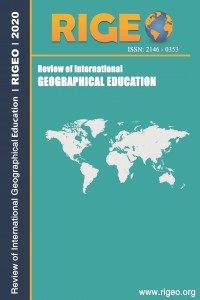Developments in Academic Geography and Its Relationship with Geographical Education – The Case of Southeast Asia.
Developments in Academic Geography and Its Relationship with Geographical Education – The Case of Southeast Asia.
For over 30 years, the Southeast Asian Geography Association (SEAGA) has provided a dynamic platform for the exchange of knowledge, research findings, and ideas among academics, policymakers, and educators from Southeast Asia and those working on Southeast Asia. Using Marsden’s (1989) notion of the politicization of geography by significant power groups, this article describes a critical narrative of the key trends, themes, and topics defining scholarly discourse in the community of SEAGA and its potential impact on school geography in the region. For each of the three decades (1990-1999, 2000-2009, and 2010-2019), the authors analyzed significant themes and issues for each period. Employing purposive sampling of conference proceedings and topics presented between 1990 and 2017, the authors found the following trends over the years: i) the pluralization and diversification of themes and topics; ii) an increasing interest for cross-thematic studies, and iii) a greater emphasis on sustainability and environmental issues in recent years. Based on these observations, the authors acknowledge that the evolution of discourses in SEAGA conferences is also a part of broader thematic shifts in international publications such as the Journal of Geography and has a direct bearing on changes in the geography curriculum in schools in other places around the world. In addition, there is a natural confluence of academic geographers and geography educators in the region in discoursing topics that matter to Southeast Asia.
___
- Alatas, S. H. (1977). The Myth of the Lazy Native: A Study of the Image of the Malays, Filipinos and Javanese from the 16th to the 20th Century and Its Function in the Ideology of Colonial Capitalism. London: Routledge.
- Billinge, M., Gregory, D., & Martin, R. (1984). Recollections of a revolution: geography as spatial science. London: Macmillan.
- Chang, C.-H. (2012). The changing climate of teaching and learning school geography: the case of Singapore. International research in geographical and environmental education, 21(4), 283-295. doi:10.1080/10382046.2012.725965
- Chang, C.-H. (2014). Is Singapore's school geography becoming too responsive to the changing needs of society? International research in geographical and environmental education, 23(1), 25-39. doi:10.1080/10382046.2013.858405
- Chang, C.-H., Simmons, B., Braus, J., Kidman, G., Mochizuki, Y., Burkhardt-Holm, P.; Matakupan, S. (2019). The Singapore Declaration on Research in Education for Sustainable Development. Retrieved from Singapore:
- Cresswell, T. (2013). Geographic thought: a critical introduction. Chichester, West Sussex, UK Wiley-Blackwell.
- International Commission on Education for the Twenty-first Century. (1996). Learning: the treasure within; report to UNESCO of the International Commission on Education for the Twenty-first Century. Retrieved from Paris, France:
- International Geographic Union - Commission on Geographical Education. (1992). International Charter on Geographic Education. Retrieved from
- International Geographic Union - Commission on Geographical Education. (2016). International Charter on Geographical Education. Retrieved from http://www.igu-cge.org/2016-charter/
- Marsden, W. E. (1989). All in a good cause: Geography, history and the politicization of the curriculum in nineteenth and twentieth century England. Journal of Curriculum Studies, 21(6), 509-526.
- National Research Council, C. o. G., Environment, and Resources,. (1997). Rediscovering geography : new relevance for science and society (0309051991). Retrieved from https://login.libproxy.nie.edu.sg/login?url=https://search.ebscohost.com/login.aspx?direct=true&db=cat04502a&AN=nie.177372&site=eds-live&scope=site
- Ooi, G. L., & Goh, K. C. (2008). Networking for the Region and Beyond - Role of the Southeast Asian Geography Association (SEAGA). International Research in Geographical and Environmental Education, 17(4), 292-297.
- Rawding, C. (2010). What are the connections between subject developments in academic and school geography? International research in geographical and environmental education, 19(2), 119-125. doi:10.1080/10382046.2010.482198
- Said, E. W. (1978). Orientalism. New York: Pantheon Books.
- Shamsul, A. B. (2007). Producing Knowledge of Southeast Asia: A Malaysian View. Journal of Inter-Asia Cultural Studies (Special Issue), 118-138.
- Southeast Asian Geography Association. (2008). Welcome Address to SEAGA. Retrieved from https://www.seaga.info/
- Taiwo, O. (1993). Colonialism and Its Aftermath: The Crisis of Knowledge Production. Callaloo, 16(4), 891-908. doi:10.2307/2932216
- Tan, I. C., & Chang, C.-H. (2008). Geography Education for Sustainable Development in Southeast Asia. International Research in Geographical & Environmental Education, 17(4), 289-291. doi:10.1080/10382040802401490
- UNESCO. (2015). The Sustainable Development Goals. Retrieved from https://www.un.org/sustainabledevelopment/development-agenda/
- Whittlesey, D. (1954). The regional concept and the regional method. In P. James & C. F. Jones (Eds.), American Geography: Inventory and Prospect (pp. 19-68). Syracuse, NY: Syracuse University Press.
- Wizdom.ai. (2019). Journal of Geography: Content. Retrieved from https://www.wizdom.ai/journal/journal_of_geography/content/0022-1341
- Woube, M. (1999). Conference Report: 5th Southeast Asian Geography Conference on Geography and Geographic Education in the 21st Century. The Geographic Journal, 165(2), 243.
- ISSN: 2146-0353
- Başlangıç: 2011
- Yayıncı: Eyüp ARTVİNLİ
Sayıdaki Diğer Makaleler
The Readiness of Geography Teacher Trainees in Gamification Approach
Mahat HANIFAH, Hashim MOHMADİSA, Norkhaidi SAİYİDATİNA BALKHİS, Nasir NAYAN, Saleh YAZİD, Nur HAMİD, Baharudin NUR HIDAYAH, Mohd Faudzi NURUL AFIFAH
Myrto GANATSA, Marianthi TSAKALDİMİ, Petros GANATSAS
Math-Related Difficulties in Thematic Map Use in Lower Secondary Education
Martin HANUS, Lenka HAVELKOVÁ, Kateřina ŠVUBOVÁ
The Views of Social Studies Teachers on Distance Education
Purwanto PURWANTO, Sugeng UTAYA, Budi HANDOYO, Syamsul BACHRI, Daniar YULİSTİYA, Saiful AMİN
